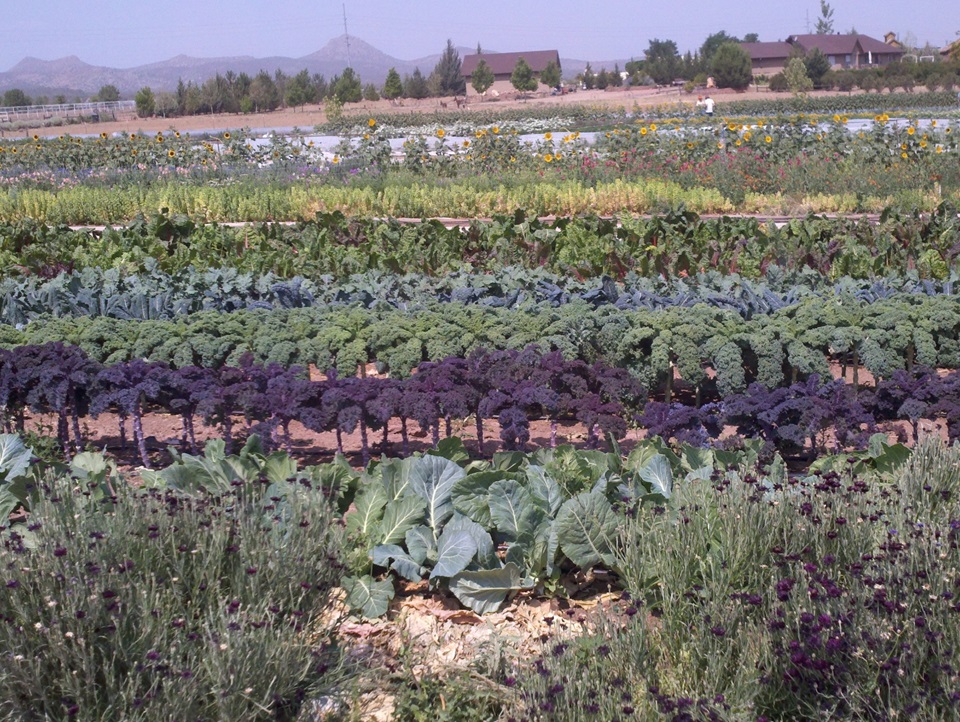 Growing Kale - October 10, 2018 Jeff Schalau, Agent, Agriculture & Natural Resources University of Arizona Cooperative Extension, Yavapai County Kale (Brassica oleracea) is a cool season vegetable in the mustard family and is easy to grow in the backyard garden. It is high in vitamins A and C, is a good source of calcium and iron and is considered one of the most nutritious of vegetables. It can be prepared in many ways: eaten raw on salads, steamed, sautéed, used in smoothies, cooked in soups and stews, and more. Kale was first cultivated in the eastern Mediterranean and Asia Minor beginning in 2000 B.C. and was used as medicinal food source and to treat bowel ailments. By the 13th century, heading types of cabbages were grown in Western Europe and by the 14th century, both heading cabbages and loose-leaf kale were being grown in England. Russian kale was introduced into Canada, and then into the United States, by Russian traders in the 19th century. Until recently, kale was primarily used in the United States for decorative purposes, but it became more popular as an edible vegetable in the 1990s due to its nutritional value. Kale prefers fertile, well-drained soil rich in organic matter for best growth. Most soils in Arizona are suitable for kale production. Soil should be prepared as it would be for any vegetable crop: incorporate up to 2-4 inches of well composted organic matter and apply a complete fertilizer (about two pounds of 10-10-10 fertilizer or equivalent amount of organic fertilizer) per 100 square feet. Alfalfa cubes can also be used as fertilizer (as described in March 29, 2017 Backyard Gardener). Additional light applications of nitrogen should also be made midseason. Kale can be grown from seed or transplants. Seeds should be planted ¼-¾ inch deep and thinned when plants have 3-4 true leaves. Plants removed at thinning can be transplanted to adjacent areas. Transplants are used to provide earlier harvest. Transplants should have 4-6 mature leaves and a well-developed root system before planting. Five to six weeks are required to grow transplants to this size. I prefer direct seeding, thinned to 12 to 18-inch spacing (depending on size of mature plants – dwarf varieties can grow on a 12-inch spacing) with rows two feet apart, and covering the bed with floating row cover. Kale grows best when temperatures do not exceed 75°F. However, young plants are not seriously damaged by temperatures down to 25°F. Mature plants are extremely hardy and can withstand very cold temperatures without damage. Transplants and direct seeded kale should be planted 4-5 weeks before the last frost free date for the growing area. Plants can be left in the garden throughout the winter to supply greens out of season. High summer temperatures reduce growth, decrease quality, and may cause bitter or off flavors to develop. Irrigate kale deeply and infrequently while trying to maintain even soil moisture. About 1-2 inches of water are required per week. Use drip irrigation if possible to conserve water. Applying mulch around the plant also helps conserve soil moisture and reduce weed growth. Moisture fluctuations will cause leaves to become tough and develop off flavors. Kale should be harvested when the leaves reach full size. Older leaves are generally stripped off the plants first allowing the young leaves to continue to grow. Frosts help improve the flavor of the fall planted crop. Kale can be stored for 2-3 weeks at 32°F and 95% relative humidity. Many gardeners leave kale growing in the garden throughout the winter. It can also be planted in fall if season extension techniques (low tunnels, floating row cover, walls of water, etc.) are used. I recently direct seeded Dwarf Blue Curled Scotch kale in mid-March 2018. It produced all summer long (was not excessively bitter) and is still producing in October. It has not yet shown any sign of bolting (flowering) and my plan is to leave it to overwinter the garden and plant another crop in March 2019. We enjoy raw kale on salads in combination with lettuces and have sautéed it with onions and used it in omelets. Consider growing some kale in your garden! It is a stout, hardy green that tolerates cold and warm temperatures. See photos and additional resources below. Follow the Backyard Gardener on Twitter – use the link on the BYG website. If you have other gardening questions, call the Master Gardener help line in the Camp Verde office at 928-554-8992 or e-mail us at verdevalleymg@gmail.com and be sure to include your name, address and phone number. Find past Backyard Gardener columns or provide feedback at the Backyard Gardener web site: http://cals.arizona.edu/yavapai/anr/hort/byg/. Photos  Dwarf Blue Curled Kale growing in Prescott, Arizona. It was planted on March 18, 2018 and the photo was taken on October 1, 2018 (photo by Jeff Schalau).
Dwarf Blue Curled Kale growing in Prescott, Arizona. It was planted on March 18, 2018 and the photo was taken on October 1, 2018 (photo by Jeff Schalau). Multiple varieties of kale growing in middle of photo at Whipstone Farm, Paulden, Arizona (photo by Jeff Schalau).
Multiple varieties of kale growing in middle of photo at Whipstone Farm, Paulden, Arizona (photo by Jeff Schalau).Additional Resources Kale in the Garden Utah State University Cooperative Extension digitalcommons.usu.edu/cgi/viewcontent.cgi?referer=&httpsredir=1&article=1274&context=extension_curall Superfoods: Kale and Spinach Montana State University Extension http://msuextension.org/magazine/articles/2407 Kale: Grow It, Eat It North Carolina State Extension content.ces.ncsu.edu/kale |